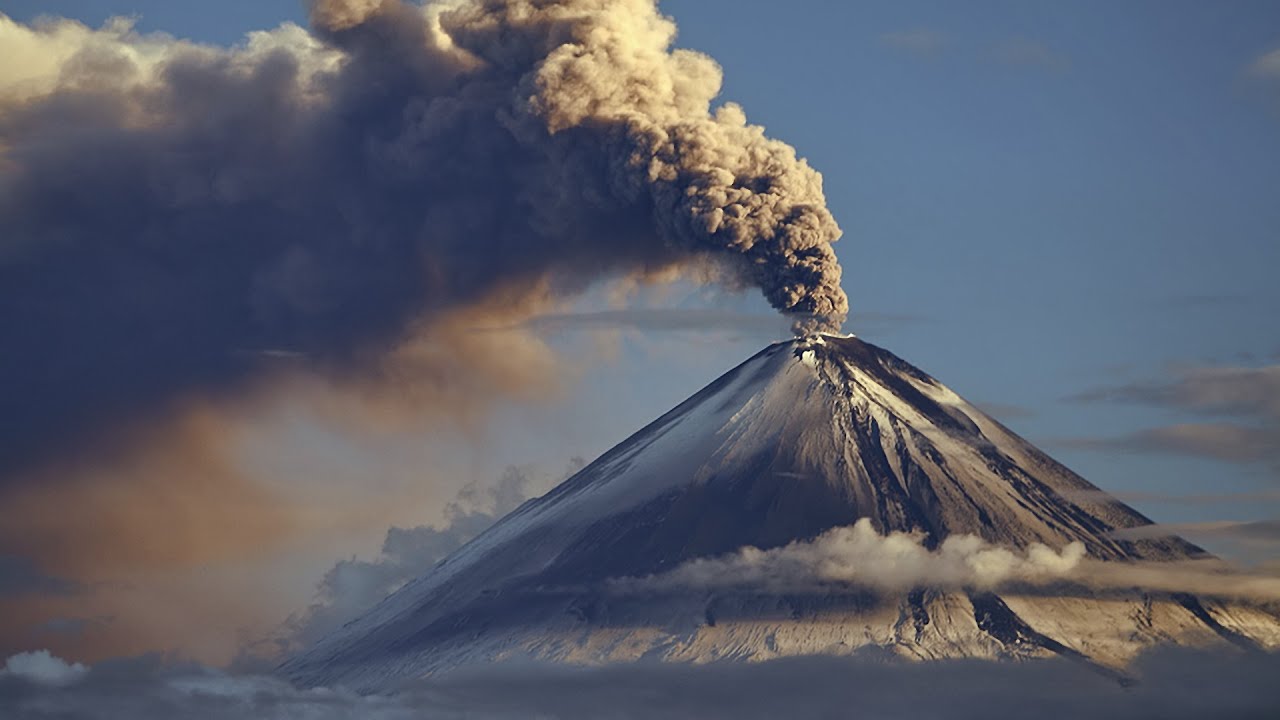You are using an out of date browser. It may not display this or other websites correctly.
You should upgrade or use an alternative browser.
You should upgrade or use an alternative browser.
Volcanoes Erupting All Over
- Thread starter Laura
- Start date
Vulcan-like explosion launched ash column more than 4.5km high and pyroclastic flows to the east and southeast at 1,000mts July 28/13: 20h / of 2021 Credits berandasleman
2:25 PM · Jul 28, 2021·
Here is the latest #volcanic #ash advisory for #Ecuador #volcano #Reventador
https://ssd.noaa.gov/VAAC/ARCH21/RE
2:25 PM · Jul 28, 2021·
Here is the latest #volcanic #ash advisory for #Ecuador #volcano #Reventador
https://ssd.noaa.gov/VAAC/ARCH21/RE
XPan
The Living Force
Sinabung Volcano, Indonesia (Sumatra)
28 July 2021


Photo; MUHAMMAD IKSAN GINTING AFP
28 July 2021
Photo; MUHAMMAD IKSAN GINTING AFP
A new intense explosion has occurred on top of the Sinabung volcano in Indonesia.
During the middle of this morning, a new powerful explosion occurred on top of the Sinabung volcano, a 2,460 m high stratovolcano on the island of Sumatra, Indonesia.
The explosion produced an eruptive column that rose about 4.5 km in altitude, causing a modest fallout of ash and lapilli along the entire southeastern side of the volcanic edifice. Also along the eastern and south-eastern slopes, the volcano generated a dense and extremely dangerous pyroclastic flow that covered about one kilometre from the top of the crater. This flow did not affect inhabited areas and consequently did not cause any particular inconvenience.
Today's explosive event did not cause any injuries or victims, especially since this type of explosion has been occurring at the top of the Sinabung volcano for almost a year. The first notable explosion occurred almost exactly one year ago, on 10 August 2020. In that case, the local authorities evacuated all villages within a 3-5 km radius of the top of the volcano. Also in August 2020, the volcano's eruptive activity changed from a purely explosive activity to a predominantly extrusive activity, i.e. a type of eruption in which the lava emitted by the volcano accumulates in the same area from which it emerges, thus generating a lava dome.
As we learned very well during the March-April eruption of the La Soufrière volcano in the Caribbean, lava domes are nothing more than an accumulation of very viscous lava that solidifies in place and grows progressively, which increases the risk of explosive activity that gives rise to frequent and very dangerous pyroclastic flows. In fact, these lava domes are not very stable and often tend to collapse completely or to crumble slowly, something that was already happening at Sinabung during the first days of February this year.
The volcanic alert has since been upgraded to level 3, and in March the volcano produced an intense explosion that generated several pyroclastic flows that travelled over 5 km along the slopes of the volcanic edifice. During that particular explosion, a good portion of the lava dome that had formed at the top of the crater was completely collapsed.
Since then, apart from sporadic, rather weak explosions, eruptive activity had returned to the extrusive phase, with the lava dome slowly increasing in size again. It is too early to know whether today's explosion has again shrunk the lava dome at the top of the crater, but explosions like today's are not unusual or unexpected for Sinabung.
Photo: Beidar Sinabung, Firdaus Surbakti.
In the last 24 hours, through the monitoring systems of the Popocatépetl volcano, 44 exhalations were identified, some of them accompanied by water vapor, volcanic gases and low ash content Additionally, two minor explosions were recorded today at 06:43. In addition, 41 minutes of low-amplitude tremor and two volcanotectonic earthquakes, the first recorded yesterday at 2:46 p.m., and the second today at 00:32, with a calculated magnitude of 1.7 and 1.6, respectively.
Reporte Volcán


Reporte Volcán
XPan
The Living Force
Etna • Sicily
From Boris Behncke, INGV Catania, Sicily
Oh by the way, my husband confirmed when i asked him, because the Southeast crater appeared pretty high - that it is indeed now the highest point of the entire Etna Volcano (see last blue photo)




From Boris Behncke, INGV Catania, Sicily
A team from the INGV, Osservatorio Etneo carried out an inspection near the South-East crater of Etna. The photos they took show well the growth of the cone, and the still fresh signs of the impact of bombs and slag, thrown with violence on the edge of the Bocca Nuova during the last paroxysms.
Photo by Boris Behncke
Oh by the way, my husband confirmed when i asked him, because the Southeast crater appeared pretty high - that it is indeed now the highest point of the entire Etna Volcano (see last blue photo)
Merapi volcano has erupted, spewing ash 3.7 kilometers into the sky.
 By: VN - 8 Aug 2021
By: VN - 8 Aug 2021
Published on Aug 9, 2021 (3:00)
More here and here.

Merapi Volcano Volcanic Ash Advisory: VA TO FL120 MOV NW FROM SUMMIT OBS VA DTG: 07/2120Z to 12000 ft (3700 m)
Merapi volcano news & eruption updates (Indonesia, Central Java)
www.volcanodiscovery.com
Published on Aug 9, 2021 (3:00)
More here and here.
XPan
The Living Force
Etna • Sicily - Italy
Paroxysm No. 53
9 Aug 2021
This morning the 53th Paroxysm went off on Etna (since 16 Feb 2021). Students from my husbands told that it was a very loud eruption (lots of noise) with strong tremor in e.g. Mascalucia and St Alifo. One friend who lives in an old building (in Mascalucia) which is 400+ years old, already had her bags packed ready to leave the house, because it was shaking/rattling so much. The tremor however stopped after 1 hour.





Paroxysm No. 53
9 Aug 2021
This morning the 53th Paroxysm went off on Etna (since 16 Feb 2021). Students from my husbands told that it was a very loud eruption (lots of noise) with strong tremor in e.g. Mascalucia and St Alifo. One friend who lives in an old building (in Mascalucia) which is 400+ years old, already had her bags packed ready to leave the house, because it was shaking/rattling so much. The tremor however stopped after 1 hour.
Line-1
This is Niijima if the eruption continues
Line-2
And the current state of the eruption of Fukutoku Okanoba, and if you can see the green flash where today's sunset is too beautiful, God
XPan
The Living Force
Fukutoku-Oka-no-Ba Volcano
I got a bit disoriented of where exactly the volcano is located, so I am adding a map here for orientation. Another info I was unaware of, is the depth of the volcano: It is only -29 meter / -95 feet below the water line. Fascinating that an eruption could result into a majestic 16 km high plume of ash !
Apparently, the whole seamount from Japan to Guam is filled with volcanic islands and underwater volcanoes... Stretching along like pearls on a string.


I got a bit disoriented of where exactly the volcano is located, so I am adding a map here for orientation. Another info I was unaware of, is the depth of the volcano: It is only -29 meter / -95 feet below the water line. Fascinating that an eruption could result into a majestic 16 km high plume of ash !
Apparently, the whole seamount from Japan to Guam is filled with volcanic islands and underwater volcanoes... Stretching along like pearls on a string.
Very high!!
1 The Fukutoku Okanoba eruption, which would have looked spectacular from Iwo Jima!
This is what South Iwo Jima looks like from Kamiyama Beach on the south side, so it should be visible in the middle of the photo.
My friend is on the island right now, but I asked him about it and he said he went fishing the night before and slept until noon, so he didn't see it...
2 It seems to have been a topic of conversation on the island, and I was sent a video that someone else had taken.
I'm going to cut out the part that doesn't cause any problems, because it's filled with conversation.
It's amazing to see the thick plume of smoke rising from the empty sea!
He said he could even see it glowing from the island.
I'm hesitant to go to that island during the Bon Festival, but I wish I could have seen it live from the island.
Translated with www.DeepL
I did a quick search through the forum but don't know if the link between CO2 emissions and volcanic eruptions has been discussed much? With some of these huge-plume volcanic eruptions, it seems fairly obvious to ask how the official numbers around AGW hysteria and human industrial activity compare to gases emitted by volcanoes per eruption.
I found the following two links interesting:

 principia-scientific.com
principia-scientific.com

The second paper also talks about ash and dust loading in the atmosphere as influencing cooling by reflecting solar radiation. So if volcanoes load particulate matter into the atmosphere "from below", and comets and meteors "from above", the convergence of these two processes could be a significant factor in major climate cycles throughout millennia. I would hypothesise this is probably much more relevant than CO2/greenhouse gases.
I found the following two links interesting:

A Volcano Eruption Can Emit More CO2 Than All Humanity. Why Worry? | Principia Scientific, Intl.
We should care about global warming and global cooling, no matter the cause. But that does not mean we should make draconian changes in global economic, political and energy policies based upon the unproven hypothesis that human emissions of CO2 are leading to apocalyptic global warming. There...
Evaluating the relationship between climate change and volcanism
A B S T R A C T Developing a comprehensive understanding of the interactions between the atmosphere and the geosphere is an ever-more pertinent issue as global average temperatures continue to rise. The possibility of more frequent volcanic eruptions
www.academia.edu
The second paper also talks about ash and dust loading in the atmosphere as influencing cooling by reflecting solar radiation. So if volcanoes load particulate matter into the atmosphere "from below", and comets and meteors "from above", the convergence of these two processes could be a significant factor in major climate cycles throughout millennia. I would hypothesise this is probably much more relevant than CO2/greenhouse gases.
Line-1
This is Niijima if the eruption continues
Line-2
And the current state of the eruption of Fukutoku Okanoba, and if you can see the green flash where today's sunset is too beautiful, God
Still relatively quiet on the Pacific Seaboard, aside from that one in Alaska recently...
And @Ryan, to steal a joke from David Dubyne, I think the AGW crowd will quite soon levy a tax against those unconscionable C02-producing volcanoes.
We can also expect the volcanoes to be revealed as racist, leading to a campaign to cancel them.
